CHOOSING SEED SOURCES | B 20 |
- introduction: biodiversity and domestication | |
What is meant by biodiversity?
The great range of variation found in living things, and in the ecosystems they form (D 10 in Manual 4)
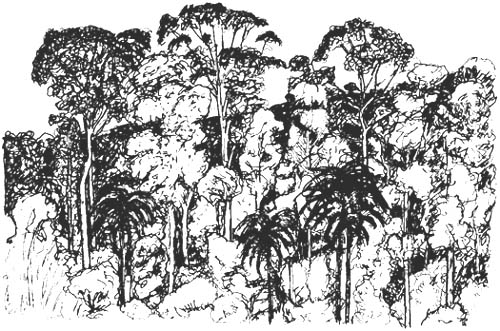
Do you mean all of it?
Yes, in the widest sense of the word; but
No, in the way this relatively new term is commonly used, which usually implies that a
particular plant or animal, or a specific habitat, is becoming depleted in its variability, and
that this needs to be corrected.
But why should I bother about variation anyway?
Because it is a fundamental feature of living organisms, which:
Are we talking about genetic variation?
The variability we see is the expression of inherent tendencies in a particular set of environmental conditions. For some characteristics of trees, the genetic contribution seems to be relatively small, whereas other features appear to be strongly inherited. It is these latter tendencies which are especially implied in the term biodiversity.
Surely people want to reduce genetic variation in crops, trees and animals!
Yes, that's right; though not too much! A balance needs to be struck between:
domestication, which is the process of finding, selecting, testing and using superior forms
for particular sites and purposes; and also breeding new ones; and
conservation, which is concerned with retaining enough biodiversity for the future.
What are the chief ways of domesticating trees?
But if you propagate from fine trees that just grew in a favourable environment, it won't do any good, will it?
You've put your finger on the chief problem that hampers tree improvement. There is so much variation there, and we usually do not know to what extent it reflects:
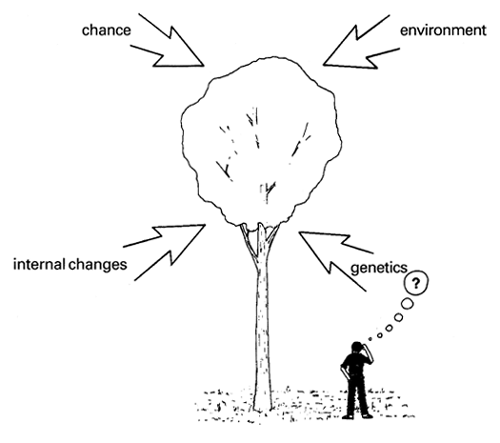
Doesn't that make it a hopeless task?
No, just one that is not all straightforward! However, the prospects of tree improvement are actually good, because:
Surely it's too difficult for an individual grower?
No, because most people raising young trees in a nursery can learn how to:
Supposing that much of the replanting of trees needed in the tropics was achieved - but with unimproved or inferior planting stock. What an opportunity would have been missed!
Yes, it certainly would. But mightn't genetic engineering allow quicker progress?
The recent very rapid developments in this field mean that there are now several other potential methods of domestication. For tropical trees, one needs to take into account:
What sort of changes might apply to tropical trees?
For example, inserting a gene that makes a tree flower early and heavily has been shown to be possible (see Weigel and Nillson, 1995 in B 51). One could ask:
Why does conservation matter as well as domestication?
Because a diversity of seed sources is always important to maintain a wide range of genetic variation into the future; especially because:
So conservation has to do with everything from future breeding programmes (B 23) to maintaining the tree cover that is important for so many reasons (B 1).
But people often talk just about preserving rare animals!
Yes they do, partly because they make attractive subjects for television documentaries. Others speak as though recording the distribution of plant species in woodlands was the only important thing. Actually, conservation has many sides to it, including not wiping out:
Conservation also needs to be incorporated into the local patterns of land-use, in order to secure the future livelihoods of the local people.
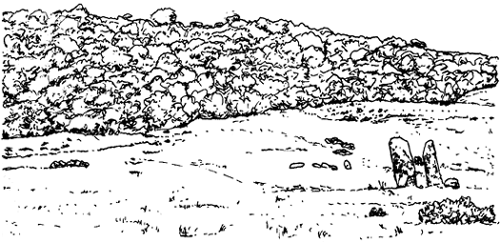
Which landscape patterns do you think can combine people's immediate needs with conservation for the future?
I see this connection being achieved in several traditional and new ways, including:
So one could have uniformity in some places and diversity in others!
Exactly! The two aims of domestication and conservation are best seen as complementary, rather than in conflict.
Then why don't we see that put into practice?
Why indeed? Perhaps some of the many reasons include:
Couldn't the approaches be altered?
Well, the way things are viewed has been changing quite rapidly, so that:
What about conserving by making large Reserves?
Many countries have designated sizeable areas as Nature Reserves (D 28 in Manual 4) and Wildlife Parks, though this has not always been done using the knowledge and with the collaboration of local people. Other kinds of conservation work include:
Can I do anything about it?
Yes! Everyone who is growing trees can help to combine domestication and conserving biodiversity, for example by:
B 21 | |
- provenance differences | |
What is a provenance?
One part of the natural range of a tree species.
How does that matter to someone planting trees?
Because trees which originate from particular provenances often thrive much better on a given site than those from other seed sources of the same species.
Why does this happen?
Over very long periods of time, the trees in one area tend to become a bit unlike those of the same species in different places. This is because they:
So they become separate genetic origins within that species?
Yes, that's right; and these have the potential to perform better, or less well, at a given site and for a particular purpose.
How big can such differences be?
Occasionally they can involve success compared with complete failure;
Often they are large enough to be easily observed; but
Sometimes it is difficult to know if they are present, because:

What features of trees can be affected?
Depending also on the environment, any characteristic of the growth and development of the trees may show differences, such as the:
How big an area does one provenance cover?
This varies a lot, depending on:
Sometimes a provenance may be designated as a:
Supposing the natural range is very small?
Then it may be better to concentrate on:
Would using one provenance reduce the variation amongst my trees a lot?
No, it is a relatively small step in the overall process of domestication (B 20).
However, it is usually best to grow more than one provenance, in case disadvantages are
found at a later stage.
Which kinds of trees have been studied most?
A lot of work on seed sources has for instance been done with teak and with several species of pines and eucalypts.
Is that because they are widely planted exotics?
Yes; and because their provenance differences have often been found to be large (B 51).
However, indigenous species can also be expected to show considerable variation, particularly when they have a wide natural range. If they have not yet been tested, concentrate on collecting your seed locally, from above-average parent trees (B 22; C 5 in Manual 3).
How are provenances tested?
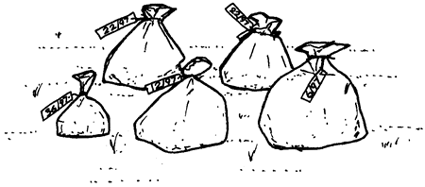
That sounds too difficult for me to undertake!
It may not be necessary, if seed is available of already tested provenances; but
It can be relatively simple to collect and test a small set of local seed sources.
What is the most important thing to remember in doing a provenance trial?
Careful labelling and good records! Most of its usefulness will be lost (C 54) if one cannot distinguish later on which provenance is which, or tell where the seed was collected (C 64–65).
But supposing nobody knows what seed source was used for a thriving stand?
Then it is best to regard it as a local race, whether it:
Note: watch out in such cases for any signs of inbreeding depression (B 22).
Doesn't importing seed cost a lot?
Not as much as using unsuitable sources for planting young trees, which are likely to:
Collaborating with other growers, and exchanging seeds, are ways of reducing the expense (B 24; C 54 in Manual 3).
How would you summarise the aims of choosing provenances?
As a first step in the genetic improvement of trees, which:
B 22 | |
- which parent trees? | |
Can't I just collect seed from any tree of an appropriate provenance?
Although this is quite often done, it is generally unwise, because you:
This is even more important than avoiding non-genetic problems like collecting fruits and seeds that contain a lot of the resting stages of pests or diseases (B 30–31).
How would I be missing out on better sources?
Selecting suitable provenances is only the first stage in domestication by seed (B 20–21; and C 5 in Manual 3). The next step is to collect seed from chosen parent trees rather than just from any of them. This is because:
Unselected seed collections quite often mean that the average performance is kept down by all the poorer trees in the provenance.
But choosing the parent trees isn't bound to give me better plants!
No, that's right. This is because:
So why is it worthwhile, then?
Because choosing the parent trees carefully is a straightforward step that makes it more
likely that the young trees you raise in your nursery and plant out will establish and grow
well.
Your aim is to move towards planting stands and individuals with genetic potentials that are
probably more appropriate to the particular site and purpose.
Could I really be going backwards rather than forwards by not bothering?
Yes, you definitely could; for instance because of:
What sort of unfavourable features might I be encouraging?
Here's one example. Some trees:
By unconsciously encouraging such unfavourable features in the seedlings you grow, it is likely that a lot of energy, sugars and minerals may be ‘wasted’ in the planted trees through unnecessary reproduction.
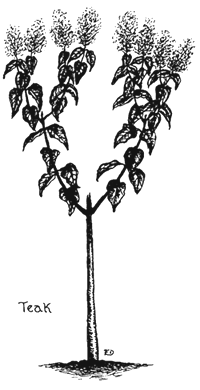
Can you give me an example?
For instance, many of the teak plantations made in Nigeria in the 1970s from tested provenances came into very heavy flowering soon after closing canopy. Since the large inflorescences are formed in the terminal bud of the leading shoot and strong upwardly growing branches, frequent forking occurs, so that there would hardly be any straight main stem to harvest for timber. It is very probable that this situation resulted from unconscious selection for early and heavy flowering, since:
In West Africa, some young teak trees even started to flower in the nursery!
But what could be done about that?
One might for instance:
Supposing I am growing a tree species mainly for its fruits?
In that case you might welcome a tendency for:
You could also select parent trees on the basis of fruit quality, size or season of ripening.
And what is inbreeding?
The fertilisation of female parts with pollen coming from trees that are closely related.
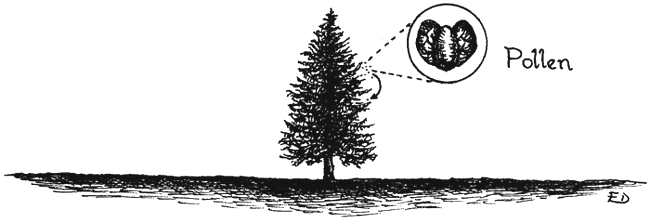
Why does that matter?
Most tree species are outbreeding, with successful progeny coming chiefly from the inter-breeding of distantly related or unrelated parents.
NOTE: seedlings from closely-related trees are generally poorer, and may be stunted.
Examples where inbreeding depression is particularly pronounced are Eucalyptus ?grandis and the temperate zone conifer Douglas fir.
Isn't that rather like human beings?
Yes - our societies have developed stringent rules against close sexual relationships, presumably because the children of near relatives often get strongly inherited disabilities and illnesses. For instance, the royal family in 19th century Britain had become inbred, and tended to suffer from haemophilia, a highly inherited condition affecting particularly the boys, in which the blood fails to clot.
How close is bad, for trees?
With most species, it is generally best to avoid collecting seed from:
When would inbreeding depression show up?
It might be already detectable in the nursery, particularly if a pot-plant trial is done (C 15 in
Manual 3), using a well-known seed-lot as a standard; but
It may not show up until a field trial has grown for some years, involving more expense and
a longer delay before the unsuitable seed sources are eliminated.
And trees can sometimes pollinate themselves!
Yes, this is not uncommon, if they produce both viable pollen and receptive female parts at the same time (B 11). However, there are often internal barriers to fertilisation (B 10), and ‘selfed’ seed is frequently empty. Any self-pollinated seedlings that occur naturally or from a breeding programme are generally inferior to those from cross-pollinations (B 23, B 50). For instance robusta coffee farms made from rooted cuttings need a minimum of two clones to set (B 12) any coffee berries at all from the flowers.
Are some kinds of trees different from this?
Yes, a few are inbreeders, in which seed from closely related trees does not show any depression, for this is the normal situation.
How can seed stands help?
Making a seed stand is the next stage in domestication by seed. It is a good way of avoiding both negative selection and inbreeding depression, and is not hard to do.
This how to set about it:
How big would the seed stand need to be?
This will vary according to species and site, but for adequate pollination usually needs to be at least 0.5 ha. You could use past nursery and seed collection records (C 54, C 63–66), together with the expected demand for seedlings, to give you an rough idea of how many parent trees might be needed, after thinning. Then double the number to be on the safe side, since surplus seed might be stored (B 33), exchanged or sold (B 24).
Could I choose part of a larger stand?
It is usually better to find a place where the whole stand can be converted, or considerable amounts of pollen may be coming in from other trees nearby.
Where should it be established?
If possible a seed stand should be:
Are seed stands unsuitable for some species?
Yes, those in which flowering is very irregular.
Could I plant trees for a seed stand?
This could be sensible if:
Another reason would be if you had evidence that a special seed stand would give better progeny. Crossing chosen trees with each other (B 23) is the stage that comes after selecting and testing for better existing sets of characters.
B 23 | |
- crossing trees with each other | |
How can domestication by seed be taken further than selecting provenances and parent trees?
By making specific crosses between chosen parent trees, and then growing on and testing their progeny.
Is this worth bothering with?
Yes it is; for the research has quite a large practical potential; but
No it may not be, for the individual grower to undertake.
So it's no use to me?
Yes, it could indeed be valuable, for instance if it had already been found that:
But how would I be able to utilise those research results?
 | Special seed stand. |
How would that differ from an ordinary seed stand?
In an ordinary seed stand (B 22), you are simply removing the trees from an existing stand
that you think may be inferior, so that they contribute neither as males nor as females (B 11)
to the seeds you collect; whereas
In a special seed stand, you could for example be planting alternate rows of those provenances
that had already been shown to produce superior progeny.
The likelihood and the extent of genetic improvement are both greater in the special type, provided that the flowering times of the provenances are similar.
What would happen if they did not overlap much?
Most of the seeds will be progeny of the two provenances, rather than crosses between them.
Could I plant a seed stand with parent trees that were known to combine well?
Usually no, because this would involve difficult procedures like grafting mature scions on to seedling rootstocks (A 3 in Manual 1), progeny testing and making a seed orchard; but Occasionally yes, if mature cuttings (B 10) of tested parental clones can be rooted easily, and they can be stimulated to flower fairly soon after planting (B 14).
And what about hybrids between species?
These could have the biggest potential, but are hardest to achieve, because:
But couldn't one collect seed from just a few outstanding hybrids?
Generally no; because:
Can pollinations be done by the grower?
Sometimes this may be possible on a small scale. For example, in wind-pollinated trees that produce a lot of pollen fairly early in life, it is possible to do ‘assisted’ pollination, where additional pollen, collected from desirable trees, is ‘puffed’ towards the receptive female parts of the other partner, in addition to natural open pollination; but
Usually crossing needs a research station with a long-term breeding programme. Then controlled pollination can be done, in which all male parts removed before they shed any pollen, and the desired female parts are enclosed in bags before they are receptive. This excludes unwanted pollen, so that when pollen from a specific tree or trees is ‘puffed’ on to them, and the bags resealed, all seeds will be of known parentage.
Supposing the pollen is shed after the females are receptive?
That's a good point. Then cross-pollinations depend on keeping pollen from a previous flowering. This involves:
Long-term storage of pollen is sometimes used as a method of conserving biodiversity (B 20).
What about flowers that are pollinated by insects or bats?
The quantity of pollen is typically much less, and it is generally sticky rather than powdery. However, on reasonably small trees it may still be possible to do assisted and controlled pollinations with a very small brush.
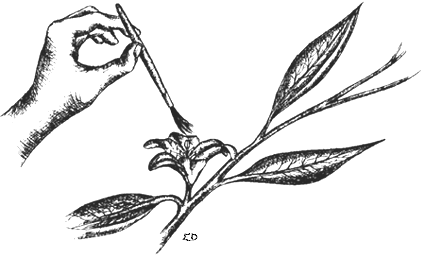
How does a research station set up a breeding programme?
This is not as straightforward as with an annual crop plant, where there are well-tried methods. Here are the traditional stages for trees, with some points to consider:
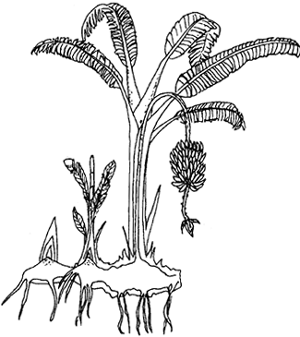
Can't this very long process be cut short?
Well, the seed-orchards can be planted at stage (D), and used first for making crosses, and later for seed production. This can work out:
I still don't see quite why it's so much harder with trees than with bananas or cereals!
Both are short-lived crops in which amounts and quality of the yield can be directly selected for each year. So:
With bananas, clones which have been selected many hundreds of times are grown vegetatively from offsets (A 3 in Manual 1) that are nearly always genetically identical to the best of the plants that have just been harvested; and
With many cereals, because they are inbreeding species (B 22), the seed for the next crop can be taken from each years' harvest, again allowing positive selection repeated each year for centuries.
While for trees?
With most of the thousands of kinds of trees, since they are long-lived, outbreeding perennials:
Well, I can see why trees have mostly stayed undomesticated!
Yes, that's right - but there are other approaches (B 2)! The best way forward for most species is probably by combining seed and vegetative propagation in a different way.
How would that be done?
Are there any other possibilities of more rapid domestication?
Yes, there are several (B 20). For example:
Large-scale improved seed production has occasionally been achieved in crop plants by using a male-sterile form for one parent. Then all the seeds collected from this parent will be crosses, not selfs.
What is the most important thing to remember when crossing trees?
To label and keep good records (C 54, C 64–66 in Manual 3)! Otherwise considerable progress could be made, but then the advantages lost.
B 24 | |
- reliable seed supplies | |
What are the different ways that I could get the seeds I need?
Occasionally there might be an opportunity to take part in local research or an international provenance trial, when seeds might be provided in return for growing them carefully and keeping simple records.
Which is the best way of ensuring regular seed supplies?
By exploring all three methods, because:
Isn't it generally best to collect one's own seed?
Yes, it often may be, since you can have better control over:
What kind of problems might I have?
Particularly if seed collection has not been done before, you would need to learn about and train staff and workers in:
Another kind of difficulty comes from lack of suitable fruiting trees, or of access to them.
What advantages are there in exchanging seeds?
For example, a village nursery in northern Ghana, set up with training and modest funding from a non-governmental organisation, is now distributing seeds to neighbouring villages where the advantages have been noted.
Couldn't there be problems with seeds exchanged with someone else?
Yes; you would need to look out for:
How could I get over such difficulties?
By building up a good relationship and agreed standards with other growers, so that you can all trust each other to:
It might for example be possible to form a seeds co-operative, which might also handle seed storage and testing.
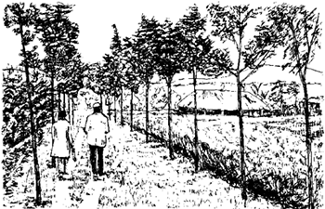 | Both farmers have planted a boundary line. |
Could I sell seeds if I had collected more than enough?
Yes, if there is a demand for them, and you can provide quality and information.
Is it really worth spending money on buying seeds?
If it can be done, it may often be very useful, for instance if:
Bought seed should generally be of high standard, recently tested for its germination percentage, and indicating any pre-sowing treatments (B 34) or special propagation conditions needed.
Wouldn't there be difficulties in getting seed from abroad?
Yes, there could be several problems, including:
If someone is travelling, bringing the seeds in their hand luggage is often the best option.
Why is keeping records of each seed-lot necessary?
Because: